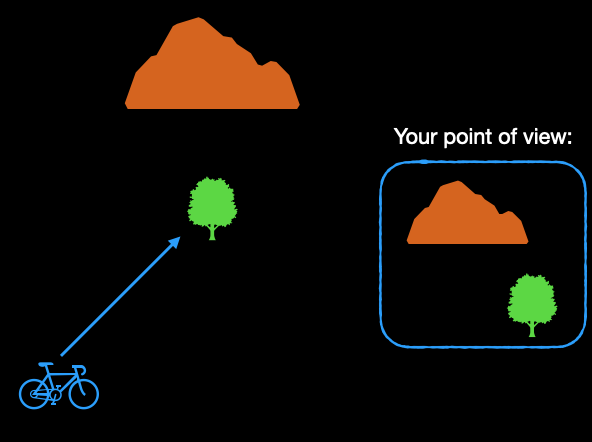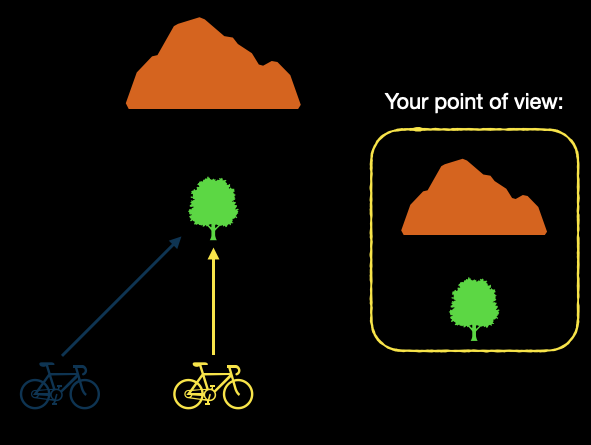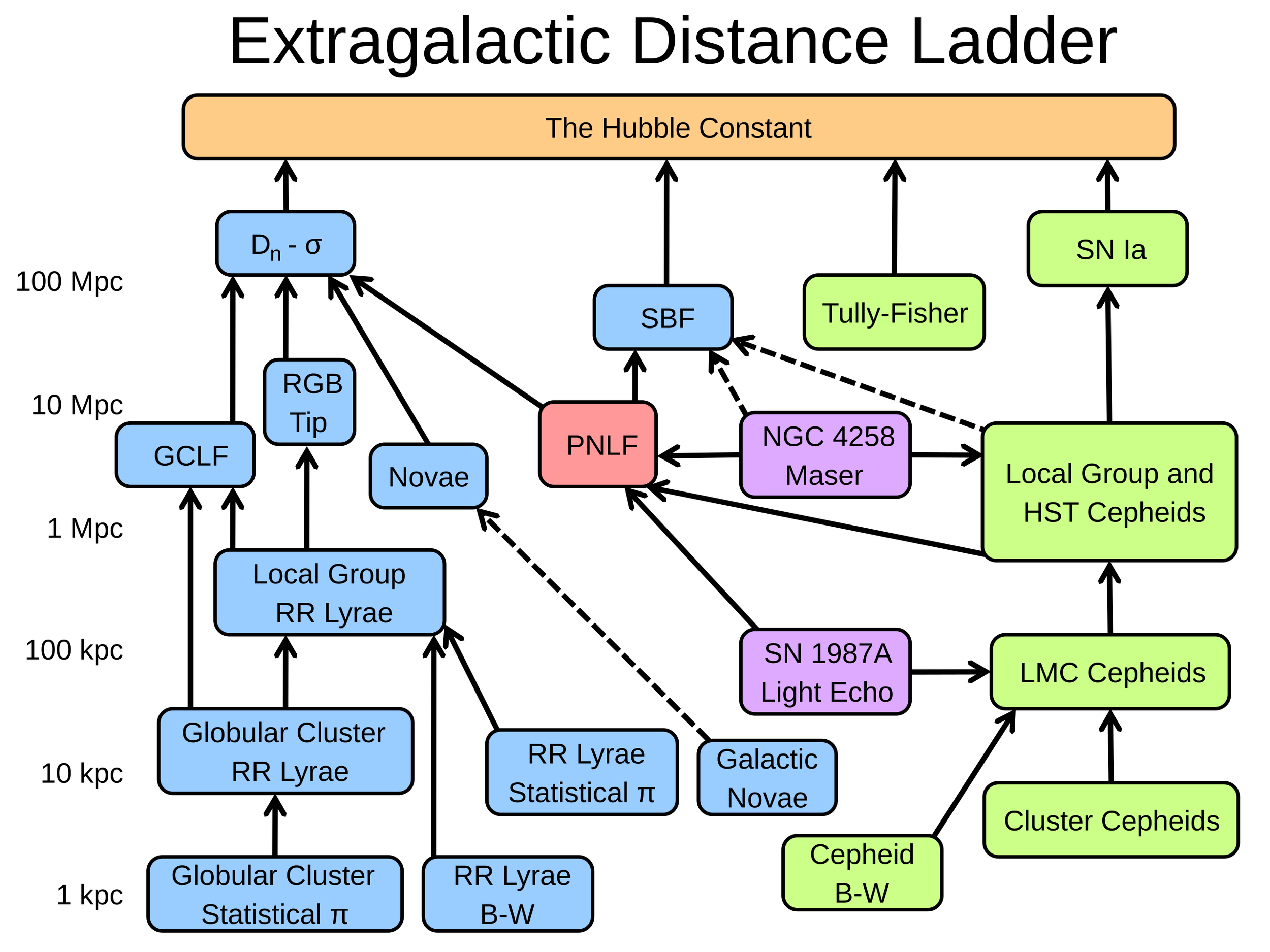Astronomy ABCs: C is for Cepheids
Aaaaaaand we’re back. Third month in a row. Did I forget that November is Thanksgiving month and because of that I need to get a post out this week or else it won’t happen? Almost. This post is based heavily on a public talk I gave a couple of years ago, so maybe it’s cheating a little. No matter. I’m here and ready for more Astronomy ABCs. We’re on letter C, and C is for Cepheids. Cepheids have an enormous role to play in the development of extragalactic astronomy, or the study of galaxies beyond the Milky Way.
Below is the Hubble Extreme Deep Field Image. It’s a combination of two Ultra Deep Field images taken in 2002 and 2003 and the Hubble Ultra Deep Field Infrared image, taken in 2009. This image represents a tiny sliver of the sky, the equivalent area of a tenth of the area of the full moon, and it captures the light from over 5000 galaxies, some of which are so distant that we see them with the Universe was 5 percent of it’s current age.
When I think of the Universe, this is part of what I think of. Huge expanses of both space and time, stretching out in all directions. Entire galaxies that look like grains of sand under a microscope. This is our modern view of the Universe. It wasn’t always that way.
The Universe, before 1920 or so, was the Milky Way Galaxy and not much else. It is true that every individual star you see in the night sky is a Milky Way star. But it’s not that we couldn’t see other galaxies. Even today on a very dark night in a very dark place you can see the Andromeda Galaxy by eye in the Northern Hemisphere and the Large and Small Magellanic Clouds in the Southern Hemisphere.
As far as astronomers of the early 20th century knew, these fuzzy patches that we know as galaxies were what they called ‘spiral nebulae,’ regions in the Milky Way made up of primarily gas with a few stars. Back then we had no real way of telling how far away these objects are, and so no real way of telling how big those objects are.
Astronomers really had one method of determining distances in space, and that is the parallax method.
Parallax
Parallax takes advantage of some well known features of trigonometry and the Earth’s movement through space to measure distance of relatively nearby objects. Here’s how it works.
Let’s say, for example, that you’re riding your bike down a straight bicycle path and in the distance you see a beautiful tree standing alone in a field with a mountain in the distance. You notice at first that the tree is to the right of the mountain. Your point of view might look something like what is in that blue box.
You see the tree relative to the background mountain.
As you ride on, your perspective on the scene will change. Now your point of view will look more like what is in the yellow box. The tree and the mountain are aligned.
Your point of view has changed!
And now you’ve gone even further and your perspective changes again. Now it will look to you that the tree is on the left of the mountain.
Your point of view changes again!
You’ve probably noticed this phenomenon before. Driving down the highway, things close to the road look like they are going by extremely fast, whereas things far away move much more slowly or not at all.
This is what happens with parallax. Just replace the tree with a nearby star and the mountain with the stationary background stars. The background stars - like the mountain - are far away enough that they can be considered stationary.
OK, so how does this movement actually help us find the DISTANCE? This is where trigonometry comes in.
We can use the distance from the Earth to the Sun as a baseline, measure the resulting parallax angle, and calculate the distance.
Stellar parallax diagram, showing how the 'nearby' star appears to move against the distant 'fixed' stars when Earth is at different positions in its orbit around the Sun. Credit: Alice Hopkinson, LCO
You might be able to tell that this method of calculating distance is extremely limiting. As the object you’re trying to measure gets further and further away, the parallax angle gets smaller and smaller and gets harder and harder to measure accurately. So astronomers could use this method to measure close-by stars in the Milky Way, but it was not so useful otherwise.
So astronomers were extremely limited in their distances measurements. But they still tried, and through those efforts estimated that the Milky Way was 300,000 light years across. Which is, honestly, not a bad estimate. We know now that the Milky Way is about 100,000 light years across. Because most astronomers in the early 20th century thought that everything in the Universe was in the Milky Way, the size of the Universe was also considered to be 300,000 light years across.
Leavitt’s Law and Cepheid Variable Stars
It was in this context that Henrietta Leavitt started on her path to changing astronomy forever.
Leavitt was born on July 4, 1868 in Lancaster, MA and graduated from Radcliffe College in 1892. After she graduated she worked as a volunteer “computer” at the Harvard Observatory until she was hired officially in 1902.
There were many women working at the Harvard Observatory as so-called computers. This was their title, but really these women were astronomers. They were doing data analysis of data taken from telescopes around the world, just like astronomers do today. One of Leavitt’s fellow Harvard computers was Annie Jump Cannon - who developed the system we use today for classifying stars. Another was Williamina Fleming, who discovered the Horsehead Nebula and the first white dwarf star, which is the final stage of life for a star like our Sun. These women did complex calculations and made significant contributions to astronomy without the aid of modern technology.
When Leavitt was hired in 1902, she was assigned to work on measuring the magnitude of stars. In particular, Leavitt studied a type of star called a Cepheid variable star in the Large and Small Magellanic Clouds.
A variable star like a Cepheid is one that changes its brightness at regular periods. Cepheids were first identified in 1784, and they have a particular type of light curve, or how bright a star is over time. The light from a normal star may change a little bit with time, but not much and not on regular intervals. A Cepheid is different. A Cepheid becomes brighter and dimmer in a predictable way.
This plot shows how the brightness of the prototypical Cepheid - Delta Cephei - changes with time. The change is brightness is very regular, peaking every 5.4 days.
There are two types of Cepheid variable star: a Type I or Classical Cepheid and a Type II Cepheid. Type I Cepheids pulsate with a period of days or months and they tend to be the youngest stars, called population 1 stars. They are massive - 4 to 20 times more massive than the sun and up to 100,000 times brighter. In one pulsating cycle the radius of Type I Cepheids can change by millions of kilometers. Type II Cepheids have periods between 1 and 50 days and tend to be older, Population II stars.
Both types of Cepheids pulsate because of the same process:
When a Cepheid is compressed, it becomes opaque. Light from inside the star cannot escape.
Photons are now trapped inside, heating the gas and increasing its pressure.
The high-pressure gas expands, and as it expands, it becomes transparent, meaning that light can escape from the interior of the star.
Photons escape, the gas cools, the pressure drops.
As the pressure drops, the Cepheid is compressed by gravity. And the process stars all over again.
Henrietta Leavitt made a couple of astonishing discoveries about Cepheid variables that would change astronomy forever. In 1908 she published her first paper on Cepheids, where the noted that the brighter Cepheids had longer pulsation periods. In 1912, Leavitt published a paper analyzing the periods and brightness of 25 Cepheids in the Small Magellanic Cloud.
She found that the average luminosity of the Cepheids - its average energy output - is linearly related to the logarithm of the period. This is called the period-luminosity relation, or more recently, Leavitt’s Law.
Plot from Leavitt's 1912 paper. The horizontal axis is the logarithm of the period of the corresponding Cepheid, and the vertical axis is its apparent magnitude. The lines drawn correspond to the stars' minimum and maximum brightness.
Above is the plot from her publication on the subject, with the horizontal axis being the period and the vertical axis as the brightness. There are two lines plotted, one represents the Cepheids at maximum brightness and one is at minimum brightness.
The modern Leavitt Law takes into account the two types of Cepheids. Plot from the lecture notes on pulsating stars from Ohio State.
Above is the modern Leavitt Law. Still basically the same, but we’ve discovered that the two types of Cepheids will give slightly different relations. But the important part of this relationship remains: You can measure the period of Cepheids and get a reliable estimate of the star’s average luminosity. Once this was calibrated, astronomers that found a new Cepheid variable star could record the period over which the star dimmed and brightened and use Leavitt’s relation to determine the star’s intrinsic brightness.
The Duel Problems of Distance and Brightness
A huge problem in astronomy was trying to figure out two things: how bright something actually is and how far away things are. How bright or dim an object looks is a function of its intrinsic properties, but it’s also a function of distance.
Illustration of the Inverse Square Law. Credit: NASA/JPL-Caltech
Every star has an intrinsic brightness, an intrinsic amount of power that it outputs, like a lightbulb. We can think of how bright a star looks as its intensity. A star has a certain intensity at the surface. It’s passing through a surface of area A. But light escapes the star in kind of a cone shape, so as the observer gets further and further away, the light must travel through a larger and larger space. If we have an observer at the star and an observer twice as far away, the star will appear 4 times fainter to the observer twice as far from the star than it would to the observer at the star, and for an observer 3 times farther away, the intensity would be 9 times fainter.
The basic physics of light really limited what astronomers could know about the stars they observed. A dim star could be a bright star that is very far away, or it could be a very dim star that is very close. Even with parallax methods, this was difficult to figure out for stars that were a moderate distance away.
Leavitt’s Law allows us to relate something that is very easy to measure - the period of a variable star - to something that is not easy to measure - the star’s intrinsic luminosity (how bright the star is close-up). If we know how bright the star *looks* and how bright the star *is,* we can calculate how far away the star is.
Cepheid variable stars are astronomy’s first so-called “standard candle,” a term coined by Henrietta Leavitt. A standard candle is something in space whose luminosity we always know.
There are other standard candles in astronomy - a particular type of supernova called a type 1a supernova comes to mind. Standard candles are an integral part of what astronomers call the cosmic distance ladder.
The Extragalactic or Cosmic Distance Ladder shows the various ways astronomers can tell how far away something is. It’s complicated!
Cosmic distance ladder is a cobbled-together mess of different methods that are valid at different distances from Earth that tell us how far away certain objects are. As you can see, there are many different methods for deterring distance. Various types of Cepheids are valid up to about a megaparsec from Earth (or 20 quintillion miles or 20 with 18 zeros).
Shapley-Curtis Debate
As Henrietta Leavitt was making her discovery, a debate is percolating. What is the scale of the Universe? The idea that there were other galaxies in the Universe was not a new one. In the 1750s, the philosopher Immanuel Kant hypothesized - with no real evidence - that spiral nebulae like Andromeda were in fact “island universes,” or galaxies like the Milky Way. This assertion stirred debate at the time, but without methods of measuring distance, it was difficult to prove one way or the other.
But by the early 1900s, there were other lines of evidence that astronomers could follow, and the debate came to a head in 1920 in something called The Great Debate, or the Shapley-Curtis debate. This was a literal debate between Harlow Shapley of the Mount Wilson Observatory and Herber D. Curtis of the Lick Observatory held at the Smithsonian Museum of Natural History. Shapley believed that the Milky Way more or less contained the entire Universe. Curtis, on the other hand, believed that spiral nebulae like Andromeda and Triangulum (another small galaxy in our Local Group) were distinct galaxies that were not encompassed by the Milky Way.
The two men had evidence to back up their ideas. Shapley, for his part, cited work done by Adriaan van Maanen in which he claims to have measured the rotational speed of the Pinwheel Galaxy, indicating that it had to be relatively close by.
Curtis noted that nova appeared at different rates inside Andromeda compared to the Milky Way. Nova are transient astronomical events where a sudden appearance of a bright star will fade over weeks or months. These are most commonly binary star system where one star steals mass from the other and temporarily becomes extremely bright. The idea is that it doesn’t make sense for Andromeda - if it was a nebula inside the Milky Way - to have more nova than other parts of the Milky Way. If Andromeda and the Milky Way were separate galaxies, this difference would make sense.
There are other details in this debate. Neither Curtis nor Shapely were right about everything, but the main question - whether or not galaxies existed outside the Milky Way - was definitively answered in 1924 by a young astronomer called Edwin Hubble.
Hubble’s Use of Leavitt’s Cepheids
Henrietta Leavitt died in 1921 when she was only 53 years old from stomach cancer. But three years after her death, her major discovery - Leavitt’s Law - was used to prove that the Universe is bigger than many astronomers at the time dared to think possible.
In 1919, Edwin Hubble was a young astronomer who had just joined the staff of the Mount Wilson Observatory near Pasadena, CA. This happened to coincide with the completion of the 100-inch diameter Hooker Telescope, which at the time was the largest telescope in the world, making it one of the best places study the universe.
And that is just what Hubble did. He decided to use Leavitt’s Law - the period-luminosity relation - to measure the distance to several nearby spiral nebula, including Andromeda and Triangulum. Using the Hooker Telescope, Hubble identified Cepheid variable stars in spiral nebulae and measured their periods. Using Leavitt’s Law, he could use these periods to determine the luminosity of the stars, and from there use the luminosity calculate their distance.
Edwin Hubble’s plate image of Andromeda. “VAR!” indicates the found a variable star in the nebula, which meant he could calculate distance using Leavitt’s Law.
Based on these measurements, Hubble estimated Andromeda to be 900,000 light years away, which is much, much farther way than the farthest reaches of the Milky Way, which, remember, was estimated to be 300,000 light years across.
By 1929, Hubble had measured the period of Cepheid variable stars in 24 other nebulae, the farthest of which was estimated to be 140 million light years away, which is REALLY beyond the accepted bounds of the Milky Way.
This put to bed the debate on whether there were other galaxies in the Universe. There were. There are. Extragalactic astronomy was born.
That was a long one, but it’s a really great story about how we all stand on each others shoulders to achieve great things. Astronomy is a team effort.










